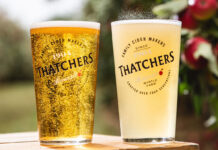Winter twists could drive gin sales in weeks ahead, distillers say
There can be no real doubt over which spirit category has been making the biggest waves in terms of growth over the last few years, as gin continues to pick up new converts at a rapid rate.

While the juniper-based spirit works wonderfully in the summer – the tonic in a G&T was originally created to protect 19th century travellers from malaria in tropical climates – distillers reckon gin sales could also warm up this winter.
To help take advantage of the sales opportunity, gin producers and distributors say there are simple steps operators can take.
Tina Connolly, brand manager at Halewood Wines & Spirits, the firm behind Whitley Neill gin, said the popularity of the traditional G&T “will withstand all seasons”, but customers may also enjoy something slightly different.
“Consumers do like to indulge with winter-inspired beverages around the Christmas period – for example, switching up ingredients for a spice-infused G&T gives a seasonal twist on an old classic,” said Connolly.
“Weekly, monthly or seasonal cocktail menus and chalk board suggestions keep serves varied and on-trend – they also initiate conversation in bars and on social [media].”
Seasonal variation may be seen this winter as gin fans begin to experiment.
Leah Shaw Hawkins of Pickering’s Gin agreed with Connolly, claiming the rise in gin sales is “intrinsically linked with the growing popularity of the G&T”, but also offered some seasonal serves that could go down well this winter.
“Although tonic remains the mixer of choice for the vast majority of gin drinkers, seasonal variation may be seen this winter as gin fans begin to experiment more with their mixers – warm serves, ginger ale and warming cocktails we’re sure will feature more and more,” she said.
Tweaking serves isn’t the only way to add a winter feel to the menu.
Eden Mill founder Paul Miller suggested operators take advantage of the seasonal variants being released by gin distilleries.
“Great gins can be enjoyed all year round, however, the really exciting thing with gin is that many of the authentic producers are producing small batch ‘seasonal’ offerings that allow drinkers to vary their gin consumption behaviour in keeping with the seasons,” said Miller.
“Oaked gins and spiced gins offer great alternatives for the winter months compared with the more citrus and aromatic summer favourites.”
Hot gin punches are another way to introduce seasonality.
Summer is never a sure thing in Scotland, but cold nights are guaranteed – and Caorunn Gin brand ambassador Sian Buchan reckons warm gin serves could win over customers as the nights draw in.
“Hot gin punches are another way to introduce seasonality to a venue’s offering,” she said.
“I do think gin lends itself to any time of year so generally people’s habits will be similar but introducing new ways to serve gin always seem welcome to customers,” said Buchan.
There’s definite sales potential for gin this winter, as SLTN’s Top Brands feature last month revealed the category is experiencing rapid growth.
With this sales growth comes expanded product knowledge on both sides of the bar, James Shelbourne of Silent Pool gin reckons.
“While very few consumers understand the nuance of different vodkas, they totally get gin,” he said.
“And with the amount of coverage the category gets in the press both bartenders and the consumer is getting better educated.”
Gin-themed events like a masterclass or tasting flight is one way to help grow knowledge while catering to customers with an interest in the category; and Shelbourne offered some advice on how operators might go about adding such events to their arsenal.
“Look to bring in one of the many brand ambassadors or distillers to help host the evening,” said Shelbourne.
“Of course they will have a particular angle but on the whole they are enthusiasts of the category and we celebrate our differences (not talking down other brands).”
Flights and masterclasses can work wonders as entertaining and educational events but there are also simple steps the trade can take to boost customer knowledge.
Leah Shaw Hawkins of Pickering’s suggested operators go beyond a simple botanical list on the bar menu by keeping some examples.
“It won’t hurt to have a few little jam jars of botanical examples to hand – maybe think about picking up some juniper berries, cardamom pods, angelica/orris root, etc.” she said.
“Having examples of some of the main flavour groups found in gin (floral, spice, citrus, bitter) to hand will really help gin fans, and hospitality teams, make the connection between the subtle notes they enjoy and where they come from.”

























